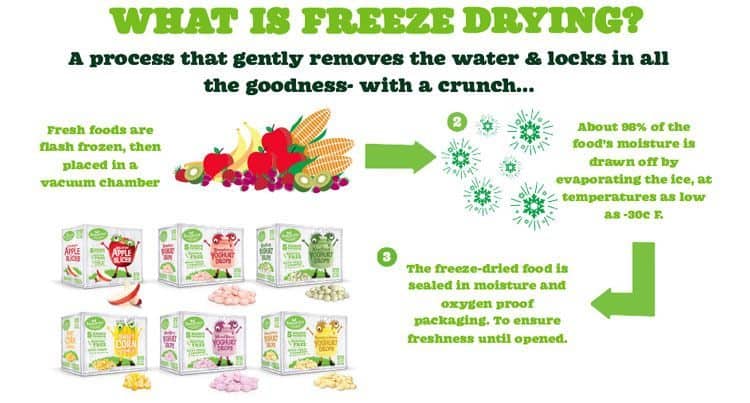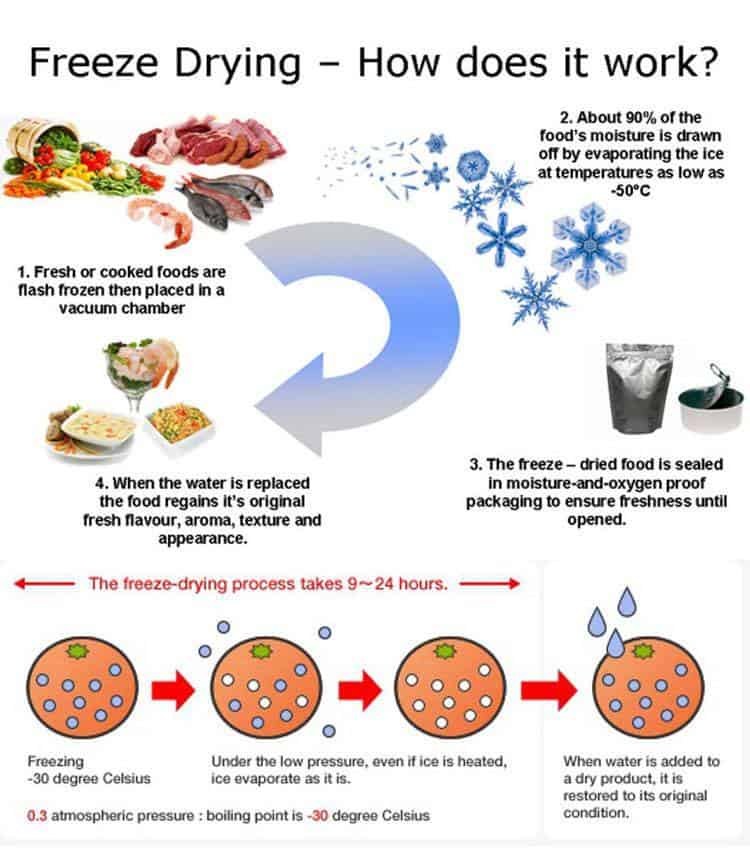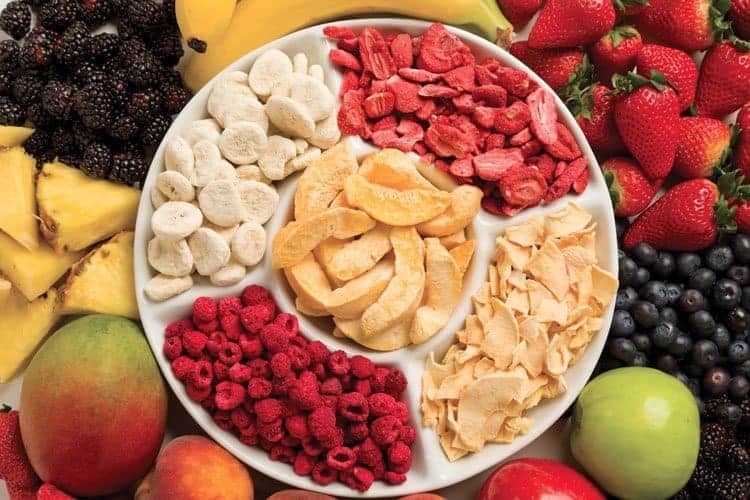When you’re out camping or on a survival mode, of course, you don’t have any immediate food supply but the food stored in your backpack.
In order to increase energy levels, you need to stay satiated. Storing emergency food supplies like in tin cans, however, can take some space inside your bag and could be heavy.
Preserving food comes in many forms like canned goods, dehydrated food, or pickled fruits. However, one process tops all of the food preservation process in many aspects.
Have you heard about the freeze-drying process? Freeze-drying food, most commonly of fruits because of how quick they are to prepare, are becoming a popular method when you need to store food for emergency purposes.
If stored right at room temperature and at right location, a freeze-dried food can still be edible after a decade!
To know the wonders of freeze-drying, read this article on how to freeze dry fruits and how you can try it in your home.
Understanding Freeze-Drying

As it is sometimes called lyophilization, it is a chemical process of preserving the edibility of the food through freezing and then drying, hence, its name. In layman’s terms, freeze-drying is like the suspended animation of the food.
Basically, you remove all the moisture and water content of the food, but the chemical composition stays the same.
Because you’re just removing the water, if you’re ready to eat it, just rejuvenate the freeze-dried food with hot water.
It is already proven in many accounts that after many years, a freeze-dried food still has its texture and taste as if prepared that same day.
If you have the necessary equipment, you can freeze-dry virtually anything! Fruits are number one on the list because they are easy to acquire, and the water content is easily sucked out.
For example, if you want to store meat through freeze-drying, you’d want to cook it first before freezing. This is because if you rehydrate a freeze-dried raw meat, it would still be raw.
Chemical Principle
The main reason why we preserve food for storage is to avoid spoilage and inhibit the growth of disease-causing bacteria.
In freeze-drying which has other names like lyophilization or cryodesiccation is a smart way to preserve a perishable food by freezing it and then reducing the atmospheric pressure.
Sublimation is the main chemical principle about freeze-drying and it makes the food shift from a solid phase into a gas phase without undergoing a liquid form (e.g. like naphthalene balls).

Normally, you place the food in a vacuum container that uses lower pressure. The first stage in the process is the pretreatment. For fruits, you may need to slice them into chewable bits, and for larger food like beef stew, you must need to cook it firsthand and wait to cool.
The second process is the freezing. This can be done in machines specific for the process alone, or you can use your freezer at home.
You will need to freeze the food to its lowest temperature where both the solid and gas phase can be both present.
The typical freezing temperatures are ranging from -50⁰C to -80⁰C and must need to be done rapidly and appropriately. This is the most crucial process because the food can be spoiled if you have done it wrong.
Drying follows the freezing process and is broken into two parts: primary and secondary drying. In the primary drying, most of the water is removed, and the pressure is lowered as controlled in a vacuum container.
Heat is also applied for the ice to sublime, thus removing the water content. Heat must be applied gradually because too much heat can change the chemical structure of the food.
The last stage is the secondary drying wherein you effectively remove the residual moisture from the primary drying. This is done by subjecting the food to higher temperatures like more than zero degrees Celsius. The estimated water content percentage after the process would then be at 1% to 4%.
Benefits of Freeze-Drying Your Food

We mentioned earlier that this process transcends most preservation process in several aspects. We’ve listed what should you know about this method:
1. Weight Reduction
Say goodbye to canned goods that are heavyweight because they’re made of tin. The original weight of the food can be several times reduced because you take out the water that what makes a food heavy.
For example, a fruit made of 90% water can be stored at its mass at 10% to make it lighter during backpacking. Military men have most of their stored food in freeze-dried form so they can carry large amounts of food as an individual.
Space astronauts also use the freeze-drying method, too, because they don’t take much space in their spacecraft.
2. Taste
As mentioned previously, the chemical composition remains intact. That means the taste, texture, and smell of the freeze-dried fruit remain the same.
Not only that, the nutrients are still the same. Some even said that when they tried eating a freeze-dried food, they’ve noticed that it had a better flavor than dehydrated food.
3. No Refrigeration
Don’t worry of refrigerating a freeze-dried food, because like dehydrated food, the oxygen and water are already removed.
Food will last for several years if kept in a cool and dry location and food spoiling will never be a problem again.
Because the mechanism of the enzymes and bacteria spoiling the food is that they need to thrive in a wet location, and the freeze-drying process retards their ripening.
4. Rehydration
Rehydration is easy with this one because the freeze-dried fruit has microscopic pores all over. They are created from the ice crystals that had sublimated.
Boiling it in hot water would take a few minutes before going back to the original state. Given that in a camping situation, you don’t always have access to boiling water, the rehydration is fast at 5-10 minutes in cold water.
5. Healthy
Freeze-dried fruits as mentioned before have the ability to retain their nutritional value as they were like freshly picked.
That’s why most professions that are long away from their homes pack freeze-dried fruits that can help them satiate their hunger while preserving their energy levels.

It is also like leading a healthy lifestyle since your food is untainted, you don’t get to eat a preserved food like a canned good that contains many additives.
6. Lots of energy
This process can be costly energy-wise because of a freeze-drying machine that uses electricity. With it, you can freeze-dry virtually everything. If not, you can use other methods like dry ice.
However, if you take in account the physical state of a dehydrated food that can appear withered and unappealing to the palate, the freeze-dried food with good-looking appearance and longer shelf life is better in the long run.
7. Shelf Life

Freeze-dried food exceeds all of the preservation processes that are currently present. In fact, a freeze-dried food has a storage life of 25 to 30 years. This is around eight times longer than a canned good or dehydrated food.
How to Freeze-Dry Fruit
In this article, we will present how to freeze-dry fruits, any kinds of fruits, because how of easy and quick they are.
We will also present some other methods in freeze-drying if you don’t have a machine for it.
1. Using your freezer
This can be a substitute to the freeze-drying machine if you don’t mind the long process. This long process is estimated to be several weeks at maximum.
To start with it. First, you will need a perforated tray. In choosing the food that you want to freeze-dry, better start with small stuff like fruits. Chop the fruit into small pieces and arrange it neatly on the perforated tray.
Small pieces are preferred because the moisture can easily be removed that way. Choose the freshest ones because when they’re rehydrated, they will still be fresh in the next years.
For the next several hours, the fruit will undergo freezing. However, the long process here will be the sublimation that will take several weeks as stated.
The water will sublimate from solid form into a gas form. Your sliced pieces of fruit will then be thoroughly dried after waiting a long time.
The way to test if your freeze-dried fruit is ready is to thaw it first. If the drying process is not complete, your fruit will turn black after melting. Return it right away to your freezer and wait for a few days.
Test it again by thawing and if doesn’t turn into a black color, that would entail that the freeze-drying process is complete. Your freeze-dried fruit is then ready to be stored in an airtight bag for storing.
2. Dry Ice
Dry ice (or cardice) is carbon dioxide in the solid phase. Freeze-drying food in this method is relatively faster than putting it directly into your freezer. The way to use dry ice is to prepare a large container, twice the size of the food you’re going to freeze-dry.
The food (in this context, fruit) that you should freeze-dry should never be in contact with dry ice, so you need to place it in a sealed plastic bag.
After you placed the food in the plastic bag then into the large container (the bottom base should already have one layer of dry ice), you can now cover the whole container with dry ice. Word of caution for this method is to always wear gloves.

Dry ice should never be melted prematurely, and that’s why you will need to store it in a freezer. Dry ice can make the moisture evaporate from the food because the environment is already at zero humidity.
As the dry ice will sublime and gas will escape, you should punch holes on your large container.
Regularly check your container every 24 hours. You will know the freeze-dried fruit is ready when all the dry ice had sublimed. After that, the freeze-dried fruit is ready for storing.
3. Vacuum Chamber
 This process could take one week or more depending on the water content of your fruit.
This process could take one week or more depending on the water content of your fruit.
To start with this, the prepared fruit that you want to freeze-dry should be frozen isolated.
You don’t want ice crystals to form, so don’t open the freezer door until several hours had passed.
Then, removing the fruit from the freezer, place it immediately inside the vacuum chamber.
The recommended temperature and pressure of the chamber should be at least 10⁰C and 120 Torr, respectively. Sublimation process will then occur and may drag on for one week. Test if the freeze-drying is complete and then it’s ready for storage.
4. Freeze-Drying Machine
This is the most expensive method but the duration in preparing the freeze-dried food takes lesser time than all of the methods mentioned above.
A typical freeze-drying machine consists of a freezing coil attached to a compressor, shelves attached to heating units, and a vacuum pump.

To use this machine, place the fruit inside the heated shelves and through the compressor, the temperature is lowered to a freezing temperature. The frozen fruit will then begin sublimation.
This is by the vacuum pump that lowers the atmospheric pressure inside by pumping it outside. The pressure becomes very low that the ice immediately shifts into a vapor form.
The food is undergoing a long process of sublimation that could take a few days at maximum.
Storing Process
To keep your food edible for few more years, you need to store it properly. Storing it in a container without a trace of air should work, like using a vacuum-sealing machine. If not, store it in a plastic zipper and make sure no air enters as you zip it close.
Place it in a cool and dry place away from direct sunlight and the freeze-dried fruit will surely take a long time before decomposing.
Conclusion
This ends the topic on how to freeze-dry fruit. Now that you know the techniques and mechanisms behind this process, you are now ready to face a financial crisis or an emergency disaster that would require you to depend on your stock food.
Indeed, man has continually improved the technology and innovated the ways of preserving food that if used right, you don’t need to be hungry in times of need anymore.

